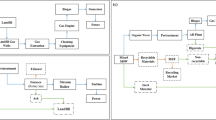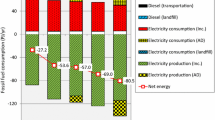Abstract
With the rapid growth of municipal solid waste (MSW) generation, waste-to-energy (WTE) incineration has gained popularity due to its potential for electricity generation and swiftly reducing the volume and mass of MSW. Recognizing the urgency of MSW management, Beijing’s government launched the “MSW Source Separation Regulation” on May 1, 2020. This paper attempts to take into account the different levels of MSW source separation as well as the impact of different MSW compositions on energy recovery potential from incineration. We assume that the MSW management level in Beijing in 2025 will reach that of developed countries (e.g., Australia), which have abundant experience and mature MSW management systems. The amount of MSW generation is predicted by a first-order and one-variable grey differential equation model, GM (1,1), and a kernel-based nonlinear multivariate grey model, KGM (1,n). We establish six scenarios and distinguish them by the composition and lower heating values (LHV) of MSW, considered with and without recycling and source separation to varying degrees. The predicted amount of MSW generation in 2025 is 11,505,400 tons with 2.255% mean absolute percentage error (MAPE). With increasing source separation and removal of food waste, the volume of electricity generated per ton of waste ranges from 0.336 to 1.114 MWh/ton. At its lowest, the cost of electricity generation is 977.60 yuan/MWh. The results not only provide implications for balancing the benefits and costs of implementing WTE incineration strategies but also shed light on government management of MSW source separation.




Similar content being viewed by others
Data availability
The data of MSW generation and its influencing factors are available in the China Statistical Yearbook repository, hyperlink to data source “https://data.cnki.net/yearbook/Single/N2020100004”. The data about the composition of MSW, LHV for each kind of components, are included in this published article Dastjerdi et al. (2019) and Li (2014).
References
Abdallah M, Shanableh A, Arab M, Shabib A, Adghim M, El-Sherbiny R (2019) Waste to energy potential in middle income countries of MENA region based on multi-scenario analysis for Kafr El-Sheikh Governorate, Egypt. J Environ Manag 232:58–65. https://doi.org/10.1016/j.jenvman.2018.11.029
Alrobaian AA (2020) Improving waste incineration CHP plant efficiency by waste heat recovery for feedwater preheating process: energy, exergy, and economic (3E) analysis. J Braz Soc Mech Sci Eng 42:403. https://doi.org/10.1007/s40430-020-02460-w
Bosire E, Oindo B, Atieno JV (2017) Modeling household solid waste generation in urban estates using socioeconomic and demographic data, Kisumu City. Maseno University Repository, Kenya. https://repository.maseno.ac.ke/handle/123456789/441. Accessed 1 Mar 2020
Chang YF, Lin CJ, Chyan JM, Chen IM, Chang JE (2007) Multiple regression models for the lower heating value of municipal solid waste in Taiwan. J Environ Manag 85:891–899. https://doi.org/10.1016/j.jenvman.2006.10.025
Chen C (2010) Spatial inequality in municipal solid waste disposal across regions in developing countries. Int J Environ Sci Technol 7:447–456. https://doi.org/10.1007/BF03326154
Dastjerdi B, Strezov V, Kumar R, Behnia M (2019) An evaluation of the potential of waste to energy technologies for residual solid waste in New South Wales, Australia. Renew Sust Energ Rev 115:109398. https://doi.org/10.1016/j.rser.2019.109398
Dalmo FC, Simão NM, Lima HQD, Jimenez ACM, Nebra S, Martins G, Palacios-Bereche R, Sant’Ana PHM (2019) Energy recovery overview of municipal solid waste in São Paulo State, Brazil. J Clean Prod 212:461–474. https://doi.org/10.1016/j.jclepro.2018.12.016
Deng JL (1982) Control problems of grey systems. Syst Control Lett 1:288–294. https://doi.org/10.1016/S0167-6911(82)80025-X
Deng JL (1989) Introduction to grey system theory. J Grey Syst 1:1–24. https://pdfs.semanticscholar.org/3d6b/22f0a4611319a424235c7516eb5352645616.pdf. Accessed 5 Mar 2020
Dong J, Tang YJ, Nzihou A, Chi Y, Weiss-Hortala E, Ni MJ (2018) Life cycle assessment of pyrolysis, gasification and incineration waste-to-energy technologies: theoretical analysis and case study of commercial plants. Sci Total Environ 626:744–753. https://doi.org/10.1016/j.scitotenv.2018.01.151
Escamilla-García PE, Camarillo-López RH, Carrasco-Hernández R, Fernández-Rodríguez E, Legal-Hernándeze JM (2020) Technical and economic analysis of energy generation from waste incineration in Mexico. Energy Strategy Rev 31:100542. https://doi.org/10.1016/j.esr.2020.100542
Gohlke O (2009) Efficiency of energy recovery from municipal solid waste and the resultant effect on the greenhouse gas balance. Waste Manag Res J Int Solid Wastes Public Clean Assoc ISWA 27:894–906. https://doi.org/10.1177/0734242X09349857
Gu BX, Wang HK, Chen Z, Jiang SQ, Zhu WM, Liu MM, Chen YQ, Wu Y, He S, Cheng R, Yang J, Bi J (2015) Characterization, quantification and management of household solid waste: a case study in China. Resour Conserv Recycl 98:67–75. https://doi.org/10.1016/j.resconrec.2015.03.001
He JX, Lin BQ (2019) Assessment of waste incineration power with considerations of subsidies and emissions in China. Energy Policy 126:190–199. https://doi.org/10.1016/j.enpol.2018.11.025
Huber F (2020) Modelling of material recovery from waste incineration bottom ash. Waste Manag 105(15):61–72. https://doi.org/10.1016/j.wasman.2020.01.034
Ju M, Bae SJ, Kim JY (2016) Lee DH (2016) Solid recovery rate of food waste recycling in South Korea. J Mater Cycles Waste Manag 18:419–426. https://doi.org/10.1007/s10163-015-0464-x
Karak T, Bhagat RM, Bhattacharyya P (2012) Municipal solid waste generation, composition, and management: the world scenario. Crit Rev Environ Sci Technol 42:1509–1630. https://doi.org/10.1080/10643389.2011.569871
Kayacan E, Ulutas B, Kaynak O (2010) Grey system theory-based models in time series prediction. Expert Syst Appl 37:1784–1789. https://doi.org/10.1016/j.eswa.2009.07.064
Kourkoumpas DS, Karellas S, Kouloumoundras S, Koufodimos G, Grammelis P, Kakaras E (2015) Comparison of waste-to-energy processes by means of life cycle analysis principles regarding the global warming potential impact: applied case studies in Greece, France and Germany. Waste Biomass Valoriz 6:605–621. https://doi.org/10.1007/s12649-015-9367-2
Kumar A, Samadder SR (2017) A review on technological options of waste to energy for effective management of municipal solid waste. Waste Manag 69:407–422. https://doi.org/10.1016/j.wasman.2017.08.046
Li CY (2014) Beijing urban areas MSW physical and chemical properties investigation. Dissertation, Beijing University of Technology (in Chinese)
Li XM, Zhang CM, Li YZ, Zhi Q (2016) The status of municipal solid waste incineration (MSWI) in China and its clean development. Energy Procedia 104:498–503
Liu JH, Li Q, Gu W, Wang C (2019) The impact of consumption patterns on the generation of municipal solid waste in China: evidences from provincial data. Int J Environ Res Public Health 16:1717. https://doi.org/10.3390/ijerph16101717
Liu SF, Forrest J (2007) The current developing status on grey system theory. J Grey Syst 19:111–123. http://citeseerx.ist.psu.edu/viewdoc/download?doi=10.1.1.679.2781&rep=rep1&type=pdf. Accessed 5 Mar 2020
Lombardi L, Carnevale E, Corti A (2015) A review of technologies and performances of thermal treatment systems for energy recovery from waste. Waste Manag 37:26–44. https://doi.org/10.1016/j.wasman.2014.11.010
Lu JW, Zhang S, Hai J, Lei M (2017) Status and perspectives of municipal solid waste incineration in China: a comparison with developed regions. Waste Manag 69:170–186. https://doi.org/10.1016/j.wasman.2017.04.014
Ma X, Liu ZB (2018) The kernel-based nonlinear multivariate grey model. Appl Math Model 56:217–238. https://doi.org/10.1016/j.apm.2017.12.010
Mamede MCS (2013) Economic and environmental assessment of the energy use of solid residues in Brazil. State University of Campinas (UNICAMP) (in Portuguese)
Mehr J, Haupt M, Skutan S, Morf L, Adrianto LR, Weibel G, Hellweg S (2021) The environmental performance of enhanced metal recovery from dry municipal solid waste incineration bottom ash. Waste Manag 119:330–341. https://doi.org/10.1016/j.wasman.2020.09.001
Murer MJ, Spliethoff H, de Waal CM, Wilpshaar S, Berkhout B, van Berlo MA et al (2011) High efficient waste-to-energy in Amsterdam: getting ready for the next steps. Waste Manag Res J Int Solid Wastes Public Clean Assoc ISWA 29:20–29. https://doi.org/10.1177/0734242X11413334
Oribe-Garcia I, Kamara-Esteban O, Martin C, Macarulla-Arenaza AM, Alonso-Vicario A (2015) Identification of influencing municipal characteristics regarding household waste generation and their forecasting ability in Biscay. Waste Manag 9:26–34. https://doi.org/10.1016/j.wasman.2015.02.017
Phua ZH, Giannis A, Dong ZL, Lisak G, Ng WJ (2019) Characteristics of incineration ash for sustainable treatment and reutilization. Environ Sci Pollut Res 26:16974–16997. https://doi.org/10.1007/s11356-019-05217-8
Prevention MP (2017) The nationwide annual report of municipal solid waste pollution prevention in large and medium cities of China (in Chinese). https://www.mee.gov.cn/hjzl/sthjzk/gtfwwrfz/201912/P020191220699179334061.pdf. Accessed 1 Mar 2020
Song GJ, Sun YY, Zhao C, Liu S, Wang Y, Geng JB (2017) Social cost assessment report of municipal solid waste incineration in Beijing. Renmin University of China (in Chinese). http://nads.ruc.edu.cn/upfile/file/20170322152504_900619_56051.pdf. Accessed 7 Mar 2020
Sun L, Fujii M, Tasaki T, Dong H, Ohnishi S (2018) Improving waste to energy rate by promoting an integrated municipal solid-waste management system. Resour Conserv Recycl 136:289–296. https://doi.org/10.1016/j.resconrec.2018.05.005
Tan ST, Ho WS, Hashim H, Lee CT, Taib MR, Ho CS (2015) Energy, economic and environmental (3E) analysis of waste-to-energy (WTE) strategies for municipal solid waste (MSW) management in Malaysia. Energy Convers Manag 102:111–120. https://doi.org/10.1016/j.enconman.2015.02.010
Tang Y, Dong J, Chi Y, Zhou ZZ, Ni MJ (2017) Energy and exergy optimization of food waste pretreatment and incineration. Environ Sci Pollut Res 24:18434–18443. https://doi.org/10.1007/s11356-017-9396-4
Thanh NP, Matsui Y, Fujiwara T (2010) Household solid waste generation and characteristic in a Mekong Delta city, Vietnam. J Environ Manag 91:2307–2321. https://doi.org/10.1016/j.jenvman.2010.06.016
Themelis NJ, Barrigga MED, Estevez P, Velasco MG (2013) Guidebook for the application of waste to energy technologies in Latin America and the Caribbean. Columbia University, Earth Engineering Center, New York
Xu L, Gao P, Cui S, Liu C (2013) A hybrid procedure for MSW generation forecasting at multiple time scales in Xiamen City, China. Waste Manag 33:1324–1331. https://doi.org/10.1016/j.wasman.2013.02.012
Wang Z, Geng L (2015) Carbon emissions calculation from municipal solid waste and the influencing factors analysis in China. J Clean Prod 104:177–184. https://doi.org/10.1016/j.jclepro.2015.05.062
Wong S, Mah AXY, Nordin AH, Nyakuma BB, Ngadi N, Mat R, Amin NAS, Ho WS, Lee TH (2020) Emerging trends in municipal solid waste incineration ashes research: a bibliometric analysis from 1994 to 2018. Environ Sci Pollut Res 27:7757–7784. https://doi.org/10.1007/s11356-020-07933-y
Zaman AU (2014) Measuring waste management performance using the ‘Zero Waste Index’: the case of Adelaide, Australia. J Clean Prod 66:407–419. https://doi.org/10.1016/j.jclepro.2013.10.032
Zeng B, Luo CM, Liu SF, Bai Y, Li C (2016) Development of an optimization method for the GM(1,N) model. Eng Appl Artif Intell 55:353–362. https://doi.org/10.1016/j.engappai.2016.08.007
Zhang DQ, Tan SK, Gersberg RM (2010) Municipal solid waste management in China: status, problems and challenges. J Environ Manag 91:1623–1633. https://doi.org/10.1016/j.jenvman.2010.03.012
Zhao XG, Jiang GW, Li A, Li Y (2016) Technology, cost, a performance of waste-to-energy incineration industry in China. Renew Sust Energ Rev 55:115–130. https://doi.org/10.1016/j.rser.2015.10.137
Zhao S, Muhammad F, Yu L, Xia M, Huang X, Jiao BQ, Lu N, Li DW (2019) Solidification/stabilization of municipal solid waste incineration fly ash using uncalcined coal gangue-based alkali-activated cementitious materials. Environ Sci Pollut Res 26:25609–25620. https://doi.org/10.1007/s11356-019-05832-5
Zhou ZZ, Tang YJ, Dong J, Chi Y, Ni MJ, Li N, Zhang YF (2018) Environmental performance evolution of municipal solid waste management by life cycle assessment in Hangzhou, China. J Environ Manag 227:23–33. https://doi.org/10.1016/j.jenvman.2018.08.083
Funding
This work was supported by National Natural Science Foundation of China (Grant numbers 72072010, 71702009 and 71803007); Beijing Social Science Fund (Grant number 20GLB017); the Ministry of Education of the People’sRepublic of China (Grant number 18YJC630170); and Fundamental Research Funds for the Central Universities (Grant numbers FRF-IDRY-19-009 and FRF-TP-20-024A2).
Author information
Authors and Affiliations
Contributions
WG proposed the original idea, developed research framework, collected data, wrote and edited the manuscript. DL analyzed the data, performed the data visualization, and wrote the original manuscript. CW wrote, edited, and proofread the manuscript. All authors read and approved the final manuscript.
Corresponding author
Ethics declarations
Competing interests
The authors declare that they have no competing interests.
Additional information
Responsible Editor: Ta Yeong Wu
Publisher’s note
Springer Nature remains neutral with regard to jurisdictional claims in published maps and institutional affiliations.
Rights and permissions
About this article
Cite this article
Gu, W., Liu, D. & Wang, C. Energy recovery potential from incineration using municipal solid waste based on multi-scenario analysis in Beijing. Environ Sci Pollut Res 28, 27119–27131 (2021). https://doi.org/10.1007/s11356-021-12478-9
Received:
Accepted:
Published:
Issue Date:
DOI: https://doi.org/10.1007/s11356-021-12478-9




